 полная версия
полная версияField Book of Western Wild Flowers
Showy Milkweed
Asclèpias speciòsa
Pink
Spring, summer
West
A handsome plant, decorative in form and harmonious in coloring, with a stout stem, from one to four feet tall, and light bluish-green leaves, usually covered with white down. The flowers are sweet-scented, with woolly pedicels, purplish-pink petals, and waxy, white "hoods," the buds yellowish-pink. The cluster, about three inches across, sometimes comprises as many as fifty flowers and is very beautiful in tone, being a mass of delicately blended, warm, soft tints of pink, cream, and purple. This grows in canyon bottoms and along streams.

Showy Milkweed – Asclepias speciosa.
Pale Milkweed
Asclèpias eròsa
Greenish-white
Spring
California
This is three feet or more tall, fine-looking, though too pale, with a stout, smooth, gray-green stem and gray-green leaves, mottled with white and very stiff, the under side white-woolly, and flower-clusters two and a half inches across, composed of numerous greenish-white flowers, each half an inch long, their stalks covered with white wool.
Desert Milkweed
Asclèpias vestìta var. Mohavénsis
Yellow and pink
Spring
California
A foot and a half tall, with very fragrant flowers, and very woolly all over, especially the upper leaves, stems and buds, which are thick with long white wool. The buds are pinkish-purple and the flowers have dull pink petals and cream-colored hoods, becoming yellow, and form clusters over two inches across. This grows in the Mohave Desert and the effect is harmonious, but not so handsome as the last.
The genus Gomphocarpus is distinguished from Asclepias by the absence of horns or crests in the hoods.
Purple Milkweed
Gomphocàrpus cordifòlius (Asclepias)
Purple and yellow
Summer
Oreg., Cal.
A handsome plant, smooth all over and more or less tinged with purple, with a stout, purple stem, from one and a half to three feet tall, with rubbery, dull, light bluish-green leaves. The flowers are scentless, with purplish sepals, maroon or purple petals, and yellowish or pinkish hoods, and form a very loose graceful cluster, over three inches across, dark in color and contrasting well with the foliage. This is common in Yosemite and elsewhere in California, at moderate altitudes.
The genus Asclepiodora, of the southern part of North America, resembles Asclepias, but the flowers are larger, the petals not turned back, the hoods flatter, with crests instead of horns; leaves mainly alternate; corolla wheel-shaped; petals spreading; hoods oblong, blunt, spreading and curving upward, crested inside; five tiny appendages alternating with the anthers and forming an inner crown around the stigma. The name is from the Greek, meaning the gift of Æsculapius.
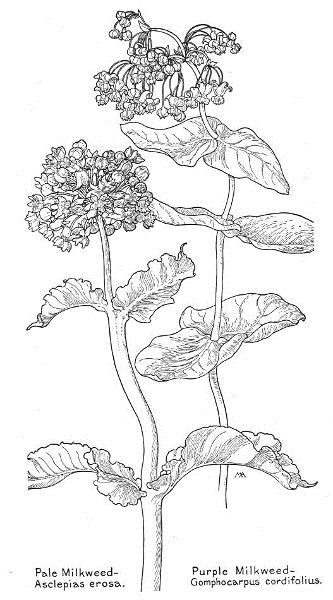
Pale Milkweed – Asclepias erosa.
Purple Milkweed – Gomphocarpus cordifolius.
Spider Milkweed
Asclepiodòra decúmbens
Green and maroon
Spring, summer
Southwest
A striking plant, though dull in color, from one to one and a half feet tall, with a rough, rather slanting stem, dull green, roughish, rather leathery leaves, and clusters of slightly sweet-scented, queer-looking flowers, each over half an inch across, with greenish-yellow petals, the hoods white inside and maroon outside, their tips curved in, a green stigma and brown anthers. The effect is a dull-yellow rosette, striped with maroon, curiously symmetrical and stiff in form, suggesting an heraldic "Tudor rose." The pods, three or four inches long, stand up stiffly, on pedicels curved like hooks. This grows on dry hillsides and is widely distributed.
DOGBANE FAMILY. Apocynaceae
A large family, widely distributed, chiefly tropical; ours are perennial herbs, with milky, bitter juice; leaves toothless, usually opposite, without stipules; flowers perfect, parts in fives; corolla united; stamens on the corolla, as many as its lobes, alternate with them, ovary superior, in two parts, united by a single or two-parted style, developing into two pods; seeds often tufted with hairs. The Greek name alludes to the superstition that these plants are poisonous to dogs.
There are many kinds of Apocynum, with branching stems, tough fibrous bark, and small, white or pink flowers, in clusters; calyx with pointed teeth, its tube adhering to the ovaries by means of a thickish, five-lobed disk; corolla bell-shaped, five-lobed, with five, small, triangular appendages, inside the tube, opposite the lobes; stamens with short, broad filaments and arrow-shaped anthers, slightly adhering to the blunt, obscurely two-lobed stigma; pod slender, cylindrical; seeds numerous, small, feathery.
Spreading Dogbane, Honey-bloom
Apócynum androsaemifòlium
White, pink
Summer
West, etc.
An attractive plant, from one to four feet high, with many, smooth, widely spreading branches, purplish on one side, and smooth leaves, rather dark green above, pale underneath, with yellowish veins. The little flowers are white, tinged with pink, often striped with pink inside, mainly in loose clusters at the ends of the branches, and though not conspicuous are delicate and pretty. The pods are from two to seven inches long. This is widely scattered in fields and open woods, occurring in a variety of forms, and common in the East.
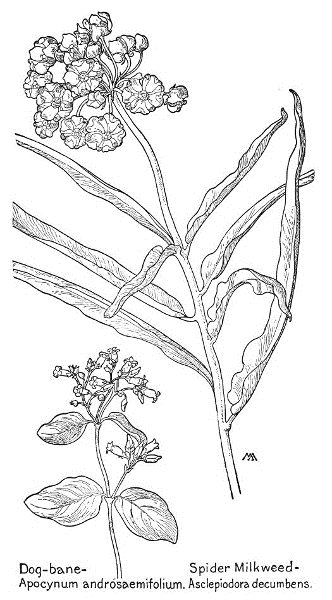
Dog-bane – Apocynum androsaemifolium.
Spider Milkweed – Asclepiodora decumbens.
BUCK-BEAN FAMILY. Menyanthaceae
A small family, widely distributed; perennial herbs, with creeping rootstocks, growing in water or marshes; the leaves smooth, alternate, or from the root; the flowers perfect, regular, in clusters; the calyx five-lobed; the corolla more or less funnel-form with five lobes or teeth; the stamens five, on the corolla and alternate with its lobes; the ovary superior, or partly so, with one cell; the fruit usually an oval capsule, with a few flattish, smooth seeds.
Buck-bean
Menyánthes trifoliàta
White
Spring, summer
Northwest
This is the only kind, a handsome plant, eight or ten inches tall, with a stout, yellowish-green stem and rich green leaves, with long, sheathing leaf-stalks and three leaflets, with toothless or somewhat scalloped edges. The flowers are about half an inch long, with a white corolla, tinged with pink or lilac, the spreading lobes covered with white hairs, with black and yellow, swinging anthers and a green pistil, with a two-lipped stigma. There are from ten to twenty flowers in each cluster and the effect is charming, suggesting a bunch of little fringed lilies. This grows in northern bogs across the continent and also in Europe and Asia. It used to be found around San Francisco, but is now extinct.
MORNING-GLORY FAMILY. Convolvulaceae
A large family, most abundant in the tropics; ours are herbs, usually with twining or trailing stems; the leaves alternate, or mere scales, without stipules; the flowers perfect, with five sepals; the corolla with united petals, more or less funnel-form and more or less five-lobed, folded lengthwise and twisted in the bud; the stamens five, on the base of the corolla; the ovary superior, with from one to three styles; the fruit usually a capsule, with from one to four large seeds.
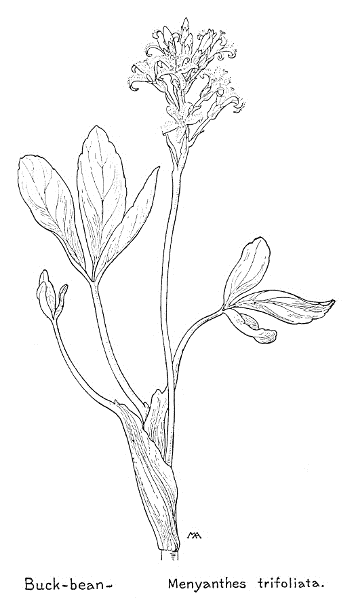
Buck-bean – Menyanthes trifoliata.
There are a great many kinds of Convolvulus, widely distributed; ours are mostly twining or prostrate perennials; the flowers large, with a slender style and two stigmas; the fruit a capsule, usually with two large seeds. The name is from the Latin, meaning "to entwine." These plants are often called Bindweed.
Field Morning-glory
Convólvulus arvénsis
White, pinkish
Spring, summer, autumn
West, etc.
This is a troublesome weed, introduced from Europe, with very deep roots and pretty flowers. The leaves are dull green and look roughish, though they are smooth or nearly so, and the flowers are about an inch across, white inside, striped with pink and tinged with yellow at the base, and pink outside, striped with duller, deeper color. The stamens and pistil are white and the buds purplish-pink. The flower stalks usually have a pair of bracts near the middle.
Yellow Morning-glory
Convólvulus occidentàlis
Cream-color
Summer
Northwest
An attractive plant, with pretty foliage and large, pale flowers, the stems trailing on the ground and climbing over low bushes. The leaves are smooth and dark bluish-green and the flowers are about two inches and a half across, very pale yellow, almost cream-color, with stripes of slightly deeper yellow, tinged with pink. The anthers and the pistil are pale yellow and the flower-stalks have two bracts just beneath the calyx.
There are many kinds of Cuscuta, or Dodder, widely distributed and difficult to distinguish; leafless parasites, without green coloring, with twining, threadlike stems and inconspicuous flowers, in clusters. The seed germinates in the soil and produces a twining stem, which attaches itself to a neighbor by means of suckers. These plants are easily recognized, for they look like tangled bunches of coarse thread, and are often very conspicuous on account of their coloring, sometimes making fine masses of bright orange-color, beautiful in tone, though the plants are very unattractive. They have other names, such as Love-vine and Strangle-weed.

Field Morning-glory – C. arvensis.
Yellow Morning-glory – Convolvulus occidentalis.
PHLOX FAMILY. Polemoniaceae
Not a large family, most abundant in western North America, a few in Europe and Asia; sometimes slightly woody; the leaves without stipules; the flowers generally regular; the calyx with five united sepals; the corolla with five united petals, rolled up in the bud and often remaining more or less twisted to one side in the flowers; the stamens with slender filaments, with swinging anthers, often unequally inserted, on the tube or throat of the corolla and alternate with its lobes; the ovary superior, with a slender style and three-lobed stigma, but in immature flowers the three branches are folded together so that the style appears to have no lobes; the pod with three compartments, containing few or many seeds, which are sometimes winged and sometimes mucilaginous.
There are a good many kinds of Polemonium, growing in cool places, usually perennials; the leaves alternate, with leaflets, not toothed; the calyx not ribbed or angled, bell-shaped; the corolla more or less bell-shaped; the stamens equally inserted, but often of unequal lengths; the seeds mucilaginous when wet. This is the Greek name, used by Dioscorides.
Jacob's Ladder
Polemònium occidentàle (P. coeruleum)
Blue
Summer
Northwest
A graceful plant, with attractive and unusual-looking foliage. The juicy stem and tender, bright green leaves are smooth or hairy and the pretty flowers are nearly three-quarters of an inch across, bright rather purplish blue, paler inside and delicately veined with blue, with a yellow "eye." The stamens are protruding, with white anthers, and the pistil is long and protruding, even in quite small buds. This is variable and grows in damp places in the mountains, across the continent and also in the Old World. The common name comes from the shape of the leaf and it is also called Greek Valerian. Another handsome sort is P. carnèum, with flowers varying in color from salmon to purple, growing in the mountains of California and Oregon, but rather rare.
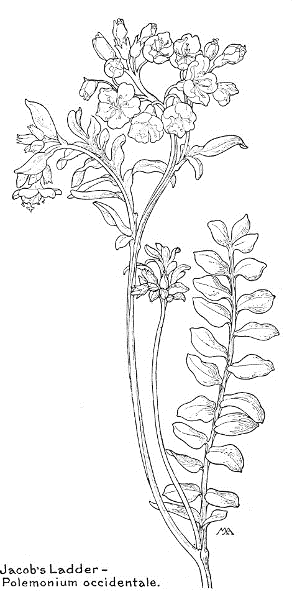
Jacob's Ladder – Polemonium occidentale.
There are many kinds of Linanthus; low, slender annuals, with opposite, palmately-divided leaves and thus differing from Gilia, the divisions narrow or threadlike, looking almost like whorls in some kinds, or rarely toothless, occasionally some of the upper leaves alternate; the flowers scattered, or in terminal, roundish clusters; the calyx-tube thin and dry between the ribs or angles, the teeth equal; the corolla more or less wheel-shaped, funnel-form, or salver-form; the stamens equally inserted on the corolla; the seeds few or many, developing mucilage when moistened. The Greek name means "flax flower."
Linánthus Párryae (Gilia)
White
Spring
California
A queer little plant, only about two inches high, with almost no stem, very small, stiff leaves, and several large, pretty flowers, with cream-white corollas, about an inch across, with five crests in the throat, and the tube tinged with purple on the outside. They are exceedingly fragile and diaphanous in texture and form little white tufts, which look very odd and attractive, sprinkled over the sand in the Mohave Desert.
Linánthus brevicùlus (Gilia)
Pink, violet
Spring
California
This has slender, purplish, rather hairy stems, from six to eight inches tall, stiff, dull green, hairy leaves, tipped with bristles, and flowers over half an inch across, with sticky, hairy calyxes. The slender corolla-tubes are half an inch long, with delicate rose-pink or violet petals, white anthers, and a whitish pistil. This looks very pretty growing on the bare sand of the Mohave Desert.
Linánthus androsàceus (Gilia)
Lilac, pink, or white
Spring, summer
California
This is very pretty, with a stiff, slender, hairy, branching stem, from three inches to a foot tall, with stiffish, dull green leaves, apparently in whorls and cut into very narrow divisions, with bristles or hairs along the margins. The flowers are over half an inch across, with a long threadlike tube, and are usually bright lilac but sometimes pink or white, with a yellow, white, or almost black "eye," orange-colored anthers and a long, yellow pistil. The flower-cluster is mixed with many bracts and the stems often branch very symmetrically, with clusters at the tips. This is common on dry hillsides, growing in the grass, and often makes bright patches of color. There are several named varieties.
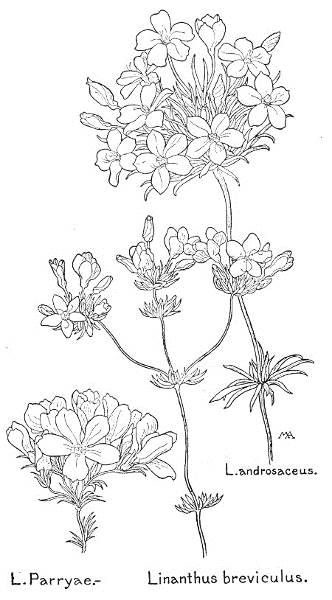
L. androsaceus.
L. Parryae.
Linanthus breviculus.
Evening Snow
Linánthus dichótomus (Gilia)
White
Spring
California
Exceedingly pretty flowers, with very slender, brown stems, often branching, from two to twelve inches tall, and a few, rather inconspicuous, dull green leaves. The flowers are an inch or more across, with a salver-form corolla, with a long slender tube, white and beautifully sheeny in texture, bordered with dull pink on the outside, showing where the petals overlapped in the bud; the stamens and pistil not showing in the throat. They have a strong and unpleasant odor, but the effect of the airy flowers is beautiful, especially in the desert, as they sway to and fro in the wind on their slender stalks. They open only in the evening, but stay open all night and keep on opening and closing for several days, getting larger as they grow older. This is common on open slopes and hills, but is variable and not easily distinguished from similar species.
Yellow Gilia
Linánthus àureus (Gilia)
Yellow
Spring
Arizona
A charming little desert plant, about three inches tall, with a very slender, usually smooth, widely branching stem and small, pale green leaves, apparently in whorls and cut into very narrow divisions, quite stiff and tipped with a bristle. The flowers are about half an inch across, bright yellow, with an orange-colored "eye" and tube, orange anthers and a yellow pistil, and they look exceedingly gay and pretty on the pale sand of the desert.
Linánthus parviflòrus (Gilia)
White, pink, lilac
Spring
California
A very pretty little plant, slightly hairy, with a slender stem, from three to ten inches tall, and clusters of small, stiff, dark green leaves. The flowers are about three-quarters of an inch across, with long, threadlike, yellow tubes, sometimes an inch and a half long, and white, pink, or lilac petals, with an orange or white "eye" and often brownish on the outside, with yellow anthers and a conspicuously long, yellow pistil. This is common throughout California, growing in open ground on hills and sea-cliffs. L. parviflorus var. aciculàris is similar, but smaller. The flowers are similar, but often have so little white about them that they are yellow in general effect, and are sometimes specked with crimson at the base of the petals. They grow in sandy places in southern California.
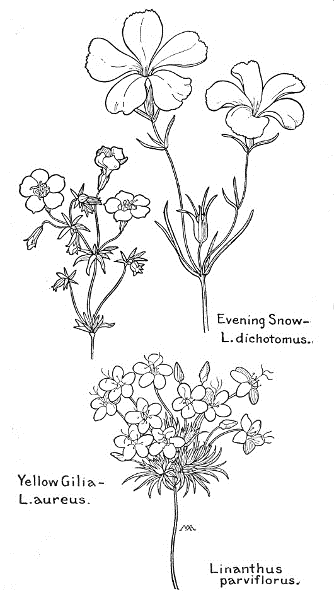
Evening Snow – L. dichotomus.
Yellow Gilia – L. aureus.
Linanthus parviflorus.
Ground Pink, Fringed Gilia
Linánthus dianthiflòrus (Gilia)
Pink
Spring
California
Charming little flowers, exceedingly delicate and gay. The stem is usually only a few inches tall, the leaves are very narrow, and the flowers are three-quarters of an inch across, with bright pink petals, prettily toothed at the tips, shading to white and yellow in the center and often with a purple ring in the throat. This is common in southern California and often grows in quantities, sprinkling the ground with its bright little flowers.
Linánthus liniflòrus (Gilia)
White
Spring, summer
California
This is a few inches tall, with purplish stems, which are so very slender and wiry that they look hardly thicker than hairs and the flowers seem to be hovering in the air, giving an exceedingly pretty and delicate effect. The leaves are stiff and dark green and the flowers are half an inch or more across, with a yellowish tube and white petals, delicately veined with blue, with a pale yellow pistil and orange anthers. This grows on the dry tops of mesas, in southern California.
There are many kinds of Phlox, natives of North America and Asia, usually perennials, the leaves toothless, mostly opposite, at least the lower ones; the calyx five-ribbed; the corolla salver-form; the stamens inserted very unequally in the tube and not protruding; the seeds not mucilaginous. The salver-form corolla and the seeds not being mucilaginous distinguishes Phlox from Gilia. The name is from the Greek, meaning "flame."
Alpine Phlox
Phlóx Douglásii
White, lilac
Summer
Northwest, etc.
A charming little plant, with woody stems a few inches tall and partly creeping along the ground, densely crowded with numerous needle-like leaves, forming dull green, cushion-like mats, sometimes over a foot across and suggesting some sort of prickly moss. These prickly cushions are sprinkled thickly all over with pretty lilac flowers and the effect is most attractive. The flowers vary in tint from white to pink and purple and are nearly three-quarters of an inch across and slightly sweet-scented. The tube is longer than the hairy calyx, and the petals fold back in fading. This grows on gravelly slopes and summits around Yosemite and in the Northwest, from the Rocky Mountains to Nebraska, and its patches of pale color are often conspicuous in dry rocky places, or in open forests, at an altitude of three to seven thousand feet.

Linanthus liniflorus.
Alpine Phlox – Phlox Douglasii.
Ground Pink – Linanthus dianthiflorus.
Wild Sweet William
Phlóx longifòlia
Pink
Spring, summer, autumn
West, etc.
Very attractive common flowers, with many stems, three to eight inches high, from a woody base. The leaves are smooth or somewhat downy, stiffish, pale gray-green and rather harsh, and the flowers are over three-quarters of an inch across, clear pink, of various shades from deep-pink to white, with an angled calyx. Only two yellow stamens show in the throat and the style is long and slender. This grows on hills and in valleys, as far east as Colorado, and its pretty flowers are very gay and charming, particularly when growing in large clumps in fields or beside the road. P. Stánsburyi, common on the plateau in the Grand Canyon, blooming in May, is similar, but has sticky hairs on the calyx.
There are many kinds of Gilia, variable and not easily distinguished; the leaves nearly always alternate and thus differing from Linanthus; the corolla funnel-form, tubular, or bell-shaped, but, unlike Phlox, rarely salver-form and the seeds are usually mucilaginous when wet. These plants were named for Gil, a Spanish botanist.
Scarlet Gilia, Skyrocket
Gília aggregàta
Red
Spring, summer, autumn
Southwest, Utah, etc.
A brilliant biennial or perennial plant, varying in general form and color. In Utah it is somewhat coarse and usually has a single, leafy, roughish, rather sticky stem, from one to two feet tall, purplish towards the top, and thickish, somewhat sticky leaves, deeply lobed and cut, in a cluster at the root and alternate along the stem, dull bluish-green in color, smooth on the under side, with more or less sparse woolly down on the upper side, as if partially rubbed off. The flowers have no pedicels, or very short ones, and form small clusters in the angles of the leaves along the upper part of the stem, but are mainly at the top, in a large, handsome, somewhat flat-topped, loose cluster. They are each more than half an inch across, with a corolla of clear scarlet, the lobes shading at base to white, finely streaked with crimson and prettily fringed at the tips. The stamens are equally or unequally inserted in the corolla throat, the buds are prettily twisted and fringed at the tips and usually have a dark purplish calyx. Sometimes the flowers are all scattered along the stalk, making a wand of bloom. This grows on mountain sides and sometimes has a very disagreeable smell, hence the local name of Polecat Plant. In Yosemite it is much more delicate in character, with several, smooth or downy, reddish, leafy stems, from one to four feet high, from a branched base, bearing very graceful clusters of flowers, the petals of various shades of scarlet, pink, and crimson, often streaked with white, or yellowish dotted with red, their long points curled back. Often the buds are scarlet and the flowers pink, giving a very vivid effect. The protruding stamens are inserted in the notches between the lobes of the corolla, with red or pink filaments and yellow or purple anthers. This has the look of a hothouse flower and is very beautiful and striking when growing in masses in high mountain woods. This has several common names which are very misleading, such as Wild Cypress and Wild Honeysuckle. There are several named varieties. It grows in the Southwest and also from British Columbia to New Mexico.

